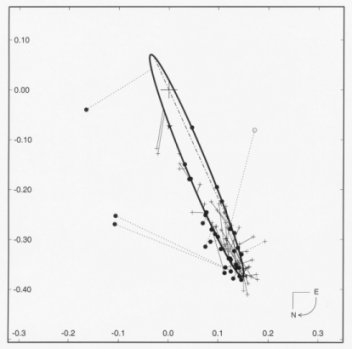
 |
The elliptical path shows the orbit of Mu Orionis B relative to Mu Ori A (indicated by the "plus sign" toward the top), that is, as if "A" were actually at the orbital focus. In reality both stars orbit a common center of mass. The scale is in seconds of arc. The orbit is seen as projected against the sky. The dot-dash line is the major axis of the true, unprojected ellipse. Not only is the true path quite elliptical, but the orbit is also presented very close to edge-on, making the apparent path even more eccentric. The observations connected to the orbit by dotted lines were not used in the calculations. The two stars, each of which is again double, take 18.644 years to make a complete circuit of each the, and were last closest together in mid-2003. (From F. C. Fekel, C. C. Scarfe, D. J. Barlow, W. I. Hartkopf, B. D. Mason, and H. A. McAlister in the Astronomical Journal, vol. 123, p. 1723, 2002.) |